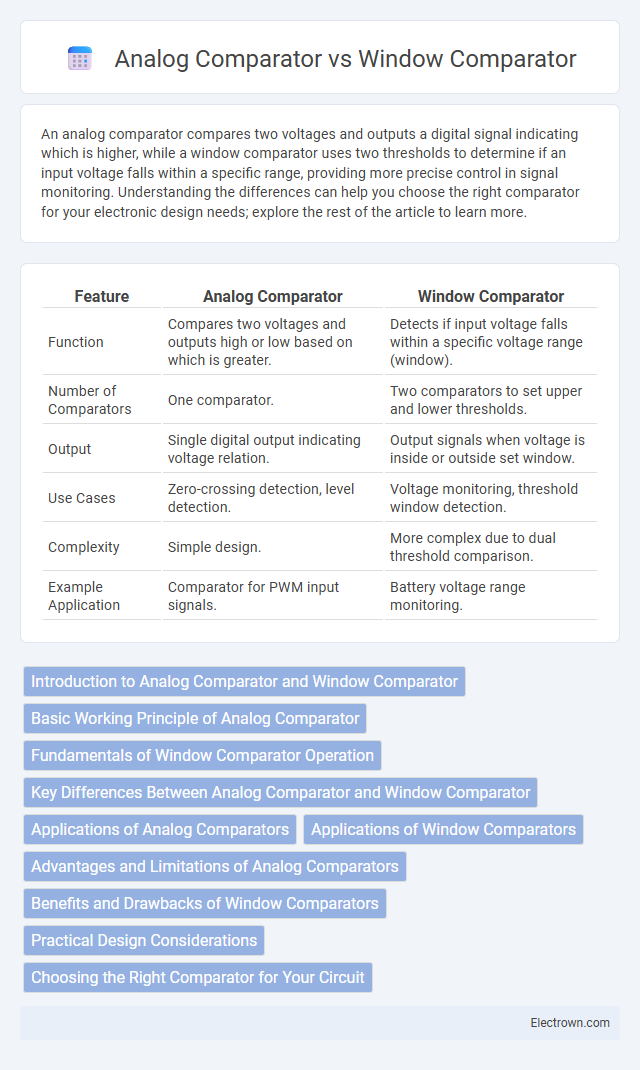An analog comparator compares two voltages and outputs a digital signal indicating which is higher, while a window comparator uses two thresholds to determine if an input voltage falls within a specific range, providing more precise control in signal monitoring. Understanding the differences can help you choose the right comparator for your electronic design needs; explore the rest of the article to learn more.
Table of Comparison
| Feature | Analog Comparator | Window Comparator |
|---|---|---|
| Function | Compares two voltages and outputs high or low based on which is greater. | Detects if input voltage falls within a specific voltage range (window). |
| Number of Comparators | One comparator. | Two comparators to set upper and lower thresholds. |
| Output | Single digital output indicating voltage relation. | Output signals when voltage is inside or outside set window. |
| Use Cases | Zero-crossing detection, level detection. | Voltage monitoring, threshold window detection. |
| Complexity | Simple design. | More complex due to dual threshold comparison. |
| Example Application | Comparator for PWM input signals. | Battery voltage range monitoring. |
Introduction to Analog Comparator and Window Comparator
An analog comparator is an electronic device that compares two voltage inputs and outputs a binary signal indicating which input is higher. A window comparator uses two analog comparators to determine if an input voltage falls within a specific voltage range or "window," providing more precise control for threshold detection. Understanding these devices helps you design circuits for signal processing, voltage monitoring, and analog-to-digital conversion.
Basic Working Principle of Analog Comparator
An analog comparator operates by comparing two input voltages and outputting a digital signal indicating which input is higher. It switches its output state when the voltage at the non-inverting input (+) exceeds that at the inverting input (-), effectively serving as a voltage-level detector. This fundamental operation forms the basis for applications such as zero-crossing detectors, pulse width modulators, and waveform generators.
Fundamentals of Window Comparator Operation
A window comparator operates by using two analog comparators to monitor whether an input voltage falls within a specific voltage range or "window," defined by upper and lower reference voltages. It outputs an indication when the input voltage is between these two thresholds, enabling precise detection of values within a set boundary. Your circuit benefits from enhanced voltage range monitoring and noise immunity compared to a single analog comparator.
Key Differences Between Analog Comparator and Window Comparator
An analog comparator compares two input voltages and outputs a digital signal indicating which input is higher, primarily functioning as a simple threshold detector. In contrast, a window comparator uses two analog comparators to determine if an input voltage lies within a specific voltage range or "window," outputting a signal when the input is between upper and lower reference voltages. Key differences include single-threshold detection in analog comparators versus dual-threshold detection in window comparators, enabling more complex voltage range monitoring in the latter.
Applications of Analog Comparators
Analog comparators are widely used in threshold detection, zero-crossing detectors, and pulse-width modulation circuits due to their fast response and simple design. Your circuits benefit from these comparators in applications like temperature monitoring, voltage level detection, and analog-to-digital conversion. Window comparators, meanwhile, specialize in detecting whether a signal lies within a specific voltage range, ideal for battery level monitoring and sensor signal validation.
Applications of Window Comparators
Window comparators are widely used in battery level monitoring to ensure voltage remains within safe operational limits, preventing overcharge or deep discharge. They are essential in precision measurement systems for detecting when signals fall inside or outside a specific voltage range, enabling accurate threshold detection. Industrial automation relies on window comparators for process control by monitoring sensor outputs and triggering alerts when values exceed predefined boundaries.
Advantages and Limitations of Analog Comparators
Analog comparators offer fast response times and simple circuit design, making them ideal for zero-crossing detectors and pulse-width modulation applications. Their limitations include susceptibility to noise and limited accuracy in detecting small voltage differences compared to window comparators, which provide more precise threshold detection by monitoring within a voltage range. You should consider these factors when selecting a comparator to ensure optimal performance in your specific application.
Benefits and Drawbacks of Window Comparators
Window comparators offer precise voltage monitoring by detecting whether an input signal remains within a defined voltage range, enhancing circuit protection and signal validation. They provide dual-threshold detection, which reduces false triggering compared to single-threshold analog comparators but require more complex circuitry and increased power consumption. Limitations include higher design complexity and potential increased response time, making them less suitable for ultra-fast comparison tasks.
Practical Design Considerations
Analog comparator design requires careful attention to input offset voltage, propagation delay, and power consumption to ensure accurate signal comparison and fast response in your application. Window comparators, combining two oppositely configured analog comparators, necessitate precise threshold setting and hysteresis control to avoid false triggering and noise sensitivity. Both demand PCB layout strategies that minimize parasitic capacitance and electromagnetic interference for reliable operation in practical circuits.
Choosing the Right Comparator for Your Circuit
Selecting the ideal comparator depends on the application requirements; analog comparators provide simple threshold detection by comparing a single input voltage against a reference. Window comparators offer dual-threshold detection by monitoring if an input voltage lies within a set voltage range, enhancing precision in applications like battery monitoring or level detection. Understanding the voltage input range and switching speed needs ensures optimal circuit performance with minimal noise and power consumption.
Analog comparator vs window comparator Infographic

 electrown.com
electrown.com